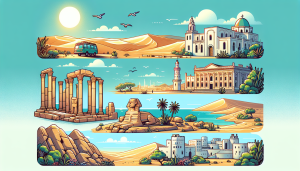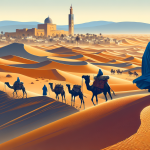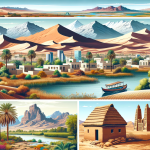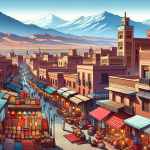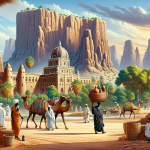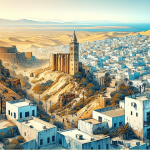Discovering Libya: A Journey Through History, Culture, and Natural Wonders
Libya, a country located in North Africa, often remains off the typical radar for many travelers. However, this enigmatic destination offers a wealth of experiences for those willing to venture beyond the well-trodden paths. From its rich tapestry of ancient history to its captivating landscapes and vibrant culture, Libya is a country that rewards the curious. With vast deserts, stunning Mediterranean coastlines, and archaeological treasures that date back millennia, Libya stands as a hidden gem waiting to be explored. In this article, we’ll delve into the myriad attractions and unique experiences that Libya has to offer, painting a comprehensive picture of why this country deserves a spot on your travel bucket list.
The Historical Significance of Libya
Ancient Civilizations
Libya’s history is a fascinating blend of various ancient civilizations. The country boasts some of the best-preserved Roman and Greek ruins in the world. Leptis Magna, often referred to as the “Rome of Africa,” is an archaeological marvel. Founded by the Phoenicians and later becoming a prominent Roman city, Leptis Magna offers an extraordinary glimpse into the past with its well-preserved amphitheater, basilica, and market place.
Cyrene: A Greek Legacy
Another gem is Cyrene, a Greek colony that dates back to 631 BC. Located near the modern town of Shahhat, Cyrene was a major center of learning and culture in the ancient world. The site includes a variety of temples, a forum, and a necropolis, offering a panoramic view of ancient Greek civilization.
The Berber Influence
Beyond the ruins of classical antiquity, Libya is also home to the Berber people, an indigenous group with a rich cultural heritage. The Berbers have inhabited North Africa for thousands of years, and their influence is evident in the architecture, language, and traditions of modern Libya.
Natural Wonders
The Sahara Desert
Libya’s natural landscapes are as compelling as its historical sites. The Sahara Desert covers much of the country, offering a surreal and breathtaking environment. The desert is home to the stunning dunes of Erg Ubari and the unique rock formations of Tadrart Acacus, both of which are UNESCO World Heritage Sites.
Mediterranean Coastline
In stark contrast to the arid desert, Libya’s coastline stretches along the Mediterranean Sea, offering beautiful beaches and crystal-clear waters. The coastal city of Tripoli, the capital of Libya, provides a perfect blend of historical intrigue and modern amenities. Here, visitors can explore the Red Castle Museum, stroll through the bustling markets, and enjoy the scenic views of the Mediterranean.
The Green Mountain
The Green Mountain (Jebel Akhdar) region in northeastern Libya is another natural wonder. This area is known for its lush vegetation, moderate climate, and archaeological sites. It stands in stark contrast to the surrounding desert and offers a unique experience for nature lovers and history buffs alike.
Cultural Richness
Traditional Libyan Cuisine
Libyan cuisine is a delightful fusion of Mediterranean, Arabic, and Berber flavors. Traditional dishes such as Bazeen (a type of bread made from barley flour) and Couscous (a staple in North African cuisine) are must-tries. Seafood is also prevalent, particularly in coastal regions, with dishes like grilled fish and seafood stews being local favorites.
Festivals and Traditions
Libya hosts a variety of festivals and cultural events throughout the year. The Ghadames Festival, held in the oasis town of Ghadames, is a celebration of Berber culture and includes traditional music, dance, and crafts. The Tripoli International Fair, one of the oldest trade fairs in Africa, showcases Libya’s economic and cultural diversity.
Arts and Crafts
Libyan arts and crafts are deeply rooted in the country’s cultural heritage. Traditional Berber jewelry, pottery, and textiles are popular souvenirs. The intricate designs and craftsmanship reflect the rich history and artistic traditions of the region.
Practical Travel Tips
Safety and Security
Traveling to Libya requires careful planning, particularly concerning safety and security. The country has experienced political instability in recent years, and it is essential to stay updated on the current situation and follow travel advisories from your government.
Visas and Travel Documentation
Obtaining a visa to Libya can be a complex process, so it’s crucial to start the application well in advance of your trip. Ensure that your passport is valid for at least six months beyond your planned stay.
Local Customs and Etiquette
Understanding and respecting local customs is vital when traveling to Libya. Dress modestly, particularly in rural areas, and be mindful of cultural sensitivities. Learning a few basic phrases in Arabic can also go a long way in enhancing your travel experience.
Conclusion
Libya is a land of contrasts and hidden treasures. From the ancient ruins of Leptis Magna and Cyrene to the stunning natural beauty of the Sahara Desert and the Mediterranean coastline, the country offers a diverse array of experiences for intrepid travelers. Despite its challenges, Libya’s cultural richness, historical significance, and natural wonders make it a destination worth exploring. By taking the necessary precautions and planning carefully, you can embark on an unforgettable journey through this fascinating North African country.
For more information on planning your trip to Libya, visit the official tourism website for the latest updates and travel advisories.
The Historical Significance of Libya
Libya’s historical significance cannot be overstated. The country has been a crossroads of civilizations for thousands of years, and its archaeological sites are a testament to its rich and diverse past.
Ancient Civilizations
Libya’s ancient history is dominated by the influence of several powerful civilizations. The Phoenicians, Greeks, and Romans all left their mark on the region, creating some of the most impressive archaeological sites in the world.
Leptis Magna
Leptis Magna, located near the modern city of Al Khums, is one of the best-preserved Roman cities in the world. The site includes a stunning amphitheater, a basilica, and a market place, offering a glimpse into the daily life of ancient Romans. The city’s architecture and urban planning are a testament to the engineering prowess of the Romans.
Cyrene
Cyrene, a Greek colony founded in 631 BC, is another must-see archaeological site. Located near the modern town of Shahhat, Cyrene was a major center of learning and culture in the ancient world. The site includes a variety of temples, a forum, and a necropolis, offering a panoramic view of ancient Greek civilization.
The Berber Influence
The Berbers have inhabited North Africa for thousands of years, and their influence is evident in the architecture, language, and traditions of modern Libya. The Berbers have a rich cultural heritage, and their traditional villages and crafts offer a unique glimpse into the history and culture of the region.
Natural Wonders
Libya’s natural landscapes are as compelling as its historical sites. The Sahara Desert covers much of the country, offering a surreal and breathtaking environment.
The Sahara Desert
The Sahara Desert is home to some of the most stunning natural landscapes in the world. The dunes of Erg Ubari and the unique rock formations of Tadrart Acacus are both UNESCO World Heritage Sites and offer a unique experience for nature lovers and adventure seekers.
Erg Ubari
Erg Ubari is a stunning region of sand dunes located in the Sahara Desert. The dunes are constantly shifting, creating a mesmerizing landscape that is both beautiful and challenging to navigate.
Tadrart Acacus
Tadrart Acacus is a region of unique rock formations located in the Sahara Desert. The area is known for its stunning landscapes and ancient rock art, which dates back thousands of years.
Mediterranean Coastline
In stark contrast to the arid desert, Libya’s coastline stretches along the Mediterranean Sea, offering beautiful beaches and crystal-clear waters.
Tripoli
The coastal city of Tripoli, the capital of Libya, provides a perfect blend of historical intrigue and modern amenities. Here, visitors can explore the Red Castle Museum, stroll through the bustling markets, and enjoy the scenic views of the Mediterranean.
The Green Mountain
The Green Mountain (Jebel Akhdar) region in northeastern Libya is another natural wonder. This area is known for its lush vegetation, moderate climate, and archaeological sites. It stands in stark contrast to the surrounding desert and offers a unique experience for nature lovers and history buffs alike.
Cultural Richness
Libya’s cultural richness is evident in its traditional cuisine, festivals, and arts and crafts.
Traditional Libyan Cuisine
Libyan cuisine is a delightful fusion of Mediterranean, Arabic, and Berber flavors. Traditional dishes such as Bazeen (a type of bread made from barley flour) and Couscous (a staple in North African cuisine) are must-tries. Seafood is also prevalent, particularly in coastal regions, with dishes like grilled fish and seafood stews being local favorites.
Festivals and Traditions
Libya hosts a variety of festivals and cultural events throughout the year. The Ghadames Festival, held in the oasis town of Ghadames, is a celebration of Berber culture and includes traditional music, dance, and crafts. The Tripoli International Fair, one of the oldest trade fairs in Africa, showcases Libya’s economic and cultural diversity.
Arts and Crafts
Libyan arts and crafts are deeply rooted in the country’s cultural heritage. Traditional Berber jewelry, pottery, and textiles are popular souvenirs. The intricate designs and craftsmanship reflect the rich history and artistic traditions of the region.
Practical Travel Tips
Traveling to Libya requires careful planning, particularly concerning safety and security. The country has experienced political instability in recent years, and it is essential to stay updated on the current situation and follow travel advisories from your government.
Safety and Security
Before traveling to Libya, it is crucial to stay informed about the current safety and security situation. Check travel advisories from your government and ensure that you are aware of any potential risks.
Visas and Travel Documentation
Obtaining a visa to Libya can be a complex process, so it’s crucial to start the application well in advance of your trip. Ensure that your passport is valid for at least six months beyond your planned stay.
Local Customs and Etiquette
Understanding and respecting local customs is vital when traveling to Libya. Dress modestly, particularly in rural areas, and be mindful of cultural sensitivities. Learning a few basic phrases in Arabic can also go a long way in enhancing your travel experience.
Conclusion
Libya is a land of contrasts and hidden treasures. From the ancient ruins of Leptis Magna and Cyrene to the stunning natural beauty of the Sahara Desert and the Mediterranean coastline, the country offers a diverse array of experiences for intrepid travelers. Despite its challenges, Libya’s cultural richness, historical significance, and natural wonders make it a destination worth exploring. By taking the necessary precautions and planning carefully, you can embark on an unforgettable journey through this fascinating North African country.
For more information on planning your trip to Libya, visit the official tourism website for the latest updates and travel advisories.
The Historical Significance of Libya
Libya’s historical significance cannot be overstated. The country has been a crossroads of civilizations for thousands of years, and its archaeological sites are a testament to its rich and diverse past.
Ancient Civilizations
Libya’s ancient history is dominated by the influence of several powerful civilizations. The Phoenicians, Greeks, and Romans all left their mark on the region, creating some of the most impressive archaeological sites in the world.
Leptis Magna
Leptis Magna, located near the modern city of Al Khums, is one of the best-preserved Roman cities in the world. The site includes a stunning amphitheater, a basilica, and a market place, offering a glimpse into the daily life of ancient Romans. The city’s architecture and urban planning are a testament to the engineering prowess of the Romans.
Cyrene
Cyrene, a Greek colony founded in 631 BC, is another must-see archaeological site. Located near the modern town of Shahhat, Cyrene was a major center of learning and culture in the ancient world. The site includes a variety of temples, a forum, and a necropolis, offering a panoramic view of ancient Greek civilization.
The Berber Influence
The Berbers have inhabited North Africa for thousands of years, and their influence is evident in the architecture, language, and traditions of modern Libya. The Berbers have a rich cultural heritage, and their traditional villages and crafts offer a unique glimpse into the history and culture of the region.
Natural Wonders
Libya’s natural landscapes are as compelling as its historical sites. The Sahara Desert covers much of the country, offering a surreal and breathtaking environment.
The Sahara Desert
The Sahara Desert is home to some of the most stunning natural landscapes in the world. The dunes of Erg Ubari and the unique rock formations of Tadrart Acacus are both UNESCO World Heritage Sites and offer a unique experience for nature lovers and adventure seekers.
Erg Ubari
Erg Ubari is a stunning region of sand dunes located in the Sahara Desert. The dunes are constantly shifting, creating a mesmerizing landscape that is both beautiful and challenging to navigate.
Tadrart Acacus
Tadrart Acacus is a region of unique rock formations located in the Sahara Desert. The area is known for its stunning landscapes and ancient rock art, which dates back thousands of years.
Mediterranean Coastline
In stark contrast to the arid desert, Libya’s coastline stretches along the Mediterranean Sea, offering beautiful beaches and crystal-clear waters.
Tripoli
The coastal city of Tripoli, the capital of Libya, provides a perfect blend of historical intrigue and modern amenities. Here, visitors can explore the Red Castle Museum, stroll through the bustling markets, and enjoy the scenic views of the Mediterranean.
The Green Mountain
The Green Mountain (Jebel Akhdar) region in northeastern Libya is another natural wonder. This area is known for its lush vegetation, moderate climate, and archaeological sites. It stands in stark contrast to the surrounding desert and offers a unique experience for nature lovers and history buffs alike.
Cultural Richness
Libya’s cultural richness is evident in its traditional cuisine, festivals, and arts and crafts.
Traditional Libyan Cuisine
Libyan cuisine is a delightful fusion of Mediterranean, Arabic, and Berber flavors. Traditional dishes such as Bazeen (a type of bread made from barley flour) and Couscous (a staple in North African cuisine) are must-tries. Seafood is also prevalent, particularly in coastal regions, with dishes like grilled fish and seafood stews being local favorites.
Festivals and Traditions
Libya hosts a variety of festivals and cultural events throughout the year. The Ghadames Festival, held in the oasis town of Ghadames, is a celebration of Berber culture and includes traditional music, dance, and crafts. The Tripoli International Fair, one of the oldest trade fairs in Africa, showcases Libya’s economic and cultural diversity.
Arts and Crafts
Libyan arts and crafts are deeply rooted in the country’s cultural heritage. Traditional Berber jewelry, pottery, and textiles are popular souvenirs. The intricate designs and craftsmanship reflect the rich history and artistic traditions of the region.
Practical Travel Tips
Traveling to Libya requires careful planning, particularly concerning safety and security. The country has experienced political instability in recent years, and it is essential to stay updated on the current situation and follow travel advisories from your government.
Safety and Security
Before traveling to Libya, it is crucial to stay informed about the current safety and security situation. Check travel advisories from your government and ensure that you are aware of any potential risks.
Visas and Travel Documentation
Obtaining a visa to Libya can be a complex process, so it’s crucial to start the application well in advance of your trip. Ensure that your passport is valid for at least six months beyond your planned stay.
Local Customs and Etiquette
Understanding and respecting local customs is vital when traveling to Libya. Dress modestly, particularly in rural areas, and be mindful of cultural sensitivities. Learning a few basic phrases in Arabic can also go a long way in enhancing your travel experience.
Conclusion
Libya is a land of contrasts and hidden treasures. From the ancient ruins of Leptis Magna and Cyrene to the stunning natural beauty of the Sahara Desert and the Mediterranean coastline, the country offers a diverse array of experiences for intrepid travelers. Despite its challenges, Libya’s cultural richness, historical significance, and natural wonders make it a destination worth exploring. By taking the necessary precautions and planning carefully, you can embark on an unforgettable journey through this fascinating North African country.
For more information on planning your trip to Libya, visit the official tourism website for the latest updates and travel advisories.
